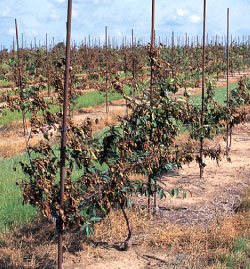
Apply all chemicals according to directions on the label. See Table 1 for examples of brands and specific fungicide products. The fungicide for use on crabapple trees is mancozeb (do not spray after bloom) or myclobutanil. For apples select one of the following: mancozeb (do not apply after bloom), myclobutanil or sulfur. If disease is severe enough to warrant chemical control, select from the chemicals below.

If possible, remove Eastern red cedars from the area or prune out galls on nearby cedars. Prevention & Treatment: Plant resistant varieties.
Apple tree fire blight treatment full#
Joseph O’Brien, USDA Forest Service, In the spring following a rain, the galls produce large, orange, gelatin-like tendrils, full of spores, which can blow up to a ½ mile to infect nearby apple or crabapple trees. Apply all pesticides according to directions on the label.Ĭedar apple rust gall on cedar in spring, after rain. Apple varieties resistant to apple scab are ‘Goldrush’, ‘Enterprise’, ‘Pristine’, ‘Gala Supreme’, ‘Liberty’, ‘Freedom’, and ‘Jonafree’.įungicides for crabapple trees are captan, mancozeb or thiophanate-methyl. If disease is severe enough to warrant chemical control, choose one of the following fungicides for use on apple trees: captan, mancozeb, thiophanate-methyl or sulfur. Rake and remove leaves to reduce early spring infection sources. Prevention & Treatment: Plant resistant varieties for best control. Slightly raised, black spots deform the fruits. Severe infections can affect the entire leaf, causing it to turn brown and drop from the tree. The disease begins in spring as dark, olive-green leaf spots that are less than ½-inch in diameter. One of the most common diseases, apple scab, is caused by the fungus Venturia inaequalis. In South Carolina, the recommended crabapple varieties that are resistant to many common diseases include ‘Adams, ‘ ‘Mary Potter,’ ‘Professor Sprenger,’ ‘Red Baron’ and ‘Indian Magic.’Ĭlemson University – USDA Cooperative Extension Slide Series, Apple Scab High resistance to scab, resistant to cedar apple rust, and somewhat resistant to powdery mildew and fire blight. ‘Freedom’ – Fruit is predominately red, with bright red stripes on a yellow background.High resistance to cedar apple rust and scab, moderate resistance to powdery mildew and fire blight. Quality and fruit color poor in eastern part of the state.

Flesh crisp, juicy, yellowish and sub-acid.

More information is available in HGIC 1007, Crabapple, and HGIC 1350, Apple. The sprays are usually a combination of fungicide and insecticide applied at the same time. However, do not expect to produce ‘store quality ‘ apples unless you are willing to go on a spray-intense pesticide program. The success of your apple-growing enterprise will depend largely on the care and attention the trees are given throughout their lifetimes. Growing apples and crabapples in South Carolina can be both fun and rewarding.


 0 kommentar(er)
0 kommentar(er)
